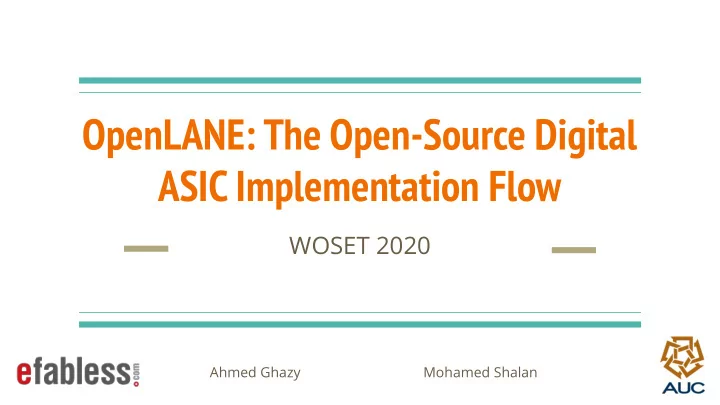

OpenLANE: The Open-Source Digital ASIC Implementation Flow WOSET 2020 Ahmed Ghazy Mohamed Shalan
Outline Introduction ● Macro Hardening Flow ● Issues and Solutions ○ Synthesis/Design Exploration and Benchmarks ○ SoC Integration Flow ● Issues and Solutions ○ striVe2a ○ Final Remarks ● Future Work ○
Introduction github.com/YosysHQ theopenroadproject.org Open Circuit Design opencircuitdesign.com
Introduction - Use Cases 1. Macro Hardening 2. SoC Integration digital_pll striVe_spi striVe_core
Introduction - Use Cases 1. Macro Hardening 2. SoC Integration digital_pll striVe_spi striVe_core
Introduction striVe2a * striVe * SRAM 1KByte Block Compiled by OpenRAM
Macro Hardening
Macro Hardening: Physical Implementation Using tools within the OpenROAD Application ● Timing optimizations done using Brown University’s OpenPhySyn ● Verification of netlist changes with Logical Equivalence Checks (LEC) ● using Yosys Custom tools: ● Two additional use cases during I/O pin placement ■ Context-aware I/O placement ● Specification-based I/O placement ● Top-level power routing ■ Antenna avoidance methodology ■
Macro Hardening: Mitigation of Antenna Effects Antenna-aware routing ● Bridging ○ Swapping of routing layers ○ Diode insertion ●
Macro Hardening: Mitigation of Antenna Effects Antenna-aware routing ● Bridging ○ Swapping of routing layers ○ Diode insertion ●
The Antenna Effect - Diode Insertion Strategies 1. Brute Force Solution Insert diodes on all poly gates (all cell inputs!) Pros Cons Eliminates most antenna violations Wasted Area - Poses a limit on ● ● core utilization Power Hungry ● Slower Performance ●
The Antenna Effect - Diode Insertion Strategies 2. “Fake Diode” Strategy - Insert fake diodes on all poly gates - Run an antenna check - Replace the fake diodes with real diodes as needed Pros Cons Eliminates most antenna violations Wasted Area - Poses a limit on ● ● core utilization
The Antenna Effect - Diode Insertion Strategies 3. Antenna-aware Tools Insert diodes only when needed during global routing (Implemented in FastRoute)
Macro Hardening: Post-routing Evaluations * * https://github.com/Cloud-V/SPEF_EXTRACTOR
Synthesis and Design Exploration Visual representation of the ● area-delay relation Find the optimal set of values for ● the configuration parameters
SkyWater Standard Cell Libraries Standard Cell Library Usage Notes High Density (HD) Stable*, Taped out (striVe, striVe2, openram_tc_1kb) High Density, Low Leakage (HDLL) Stable* High Speed (HS) Stable* Low Speed (LS) Stable* Medium Speed (MS) Unstable* High Voltage (HVL) Under test OSU 18T Under test (striVe3) * See benchmarks at https://github.com/efabless/openlane/blob/develop/regression_results/benchmark_results
SoC Integration
SoC Integration: Preparation Utilities to wrap macros to increase their ● routability (w.r.t available routers) Divides and conquers the problems of ● DRC and LVS Abstraction SRAM 1KByte Block Compiled by OpenRAM
SoC Integration: Generation of top-level description Optional ● Intended for users unfamiliar with the ● I/O pads Top-level Chip Pad Frame Design Core
SoC Integration: Pad Frame Generation PFG originally by Tim Edwards ● An OpenDB-based version ● Both based on PADRING from YosysHQ ●
SoC Integration: Learnings from striVe striVe Issue: Macro-to-macro nets causing congestion ● on the top level Sub-optimal I/O pin placement ● Unclean routes → Manual intervention ● Manual power routing ●
SoC Integration: Recommended Hierarchy striVe Issue: Macro-to-macro nets causing congestion on the top level Top-level Chip Padframe Core Core Logical Hierarchy Physical Hierarchy
SoC Integration: Context-aware Hardening striVe Issue: Sub-optimal I/O pin placement Idea: “Contextualized” Floorplanning
SoC Integration: Context-aware Hardening Applications: Context-aware various steps of the flow ● E.g., context-aware I/O placement ○
SoC Integration: Power Routing striVe Issue: Manual power routing Ideas: - Recommended hierarchy - Concentric core rings - Custom top-level power router - Maximize usage of the highest metal layer - Maximize the number of vias - DRC-correct by construction
SoC Integration: Power-routed Chip Floorplan
SoC Integration: striVe2a
SoC Integration: striVe2a Time to harden everything from ● scratch and integrate an SoC ~57 mins ○ LVS clean ● No real DRC errors seen by ● open-source tools (e.g., TritonRoute and magic)
Final Remarks SoC release is pending the open-source release of the I/O library ● OpenLANE is currently the only open-source flow that can be readily ● used to almost fully automate chip integration for the open PDK Planned to be used for the upcoming public November shuttle ●
Final Remarks: Future and Current Work Work around cons of the recommended hierarchy when it comes to ● multi-voltage designs Adapt some of the SoC features to to work with Caravel ● Target ~0 antenna violations: ● FastRoute antenna avoidance is not yet perfect ○
Final Remarks: Acknowledgements This project would not have been possible without the dedicated work by Tim Edwards, Karim Fareed, Amr Gouhar, and Mohamed Kassem.
Thanks for listening!
Recommend
More recommend